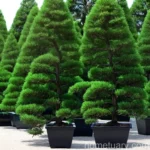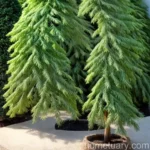Japanese Falsecypress (Chamaecyparis pisifera ‘Lemon Thread’): A Complete Guide to Care and Cultivation
Japanese falsecypress (Chamaecyparis pisifera), specifically ‘Lemon Thread’ is a stunning ornamental plant that adds beauty and elegance to any landscape. Its unique foliage and graceful form make it a desirable addition to gardens, containers, and landscapes of all types. In this comprehensive guide, we will explore all aspects of caring for and cultivating Japanese falsecypress, including its culture, uses, propagation, common diseases, and much more.
What is Japanese Falsecypress (Chamaecyparis pisifera ‘Lemon Thread’)?
Chamaecyparis pisifera ‘Lemon Thread’, commonly known as Japanese falsecypress, is a striking evergreen conifer that belongs to the cypress family (Cupressaceae). This cultivar is renowned for its delicate, thread-like foliage, which emerges as vibrant yellow-green in spring and matures to a rich golden-yellow hue as the season progresses. The compact, mounding habit and attractive coloration make ‘Lemon Thread’ an eye-catching plant in any setting.
Key Takeaways – Japanese Falsecypress (Chamaecyparis pisifera ‘Lemon Thread’):
- Scientific Name: Chamaecyparis pisifera ‘Lemon Thread’
- Common Name: Japanese Falsecypress ‘Lemon Thread’
- Foliage Color: Yellow-green in spring, maturing to golden-yellow
- Habit: Compact, mounding
- Family: Cupressaceae
- Uses: Ornamental, container, landscape
Culture of Japanese Falsecypress (Chamaecyparis pisifera ‘Lemon Thread’)
Understanding the cultural requirements of Japanese falsecypress is essential for ensuring its optimal growth and health. This section will delve into the specifics of its cultivation needs, including water, sunlight, fertilizer, and soil requirements.
Water
- Watering Needs: Moderate
- Frequency: Water deeply when the top inch of soil feels dry
- Avoid: Waterlogged conditions
Sunlight
- Sun Exposure: Full sun to partial shade
- Optimal: Full sun for best foliage coloration
- Shade Tolerance: Moderate
Fertilizer
- Fertilization: Apply balanced, slow-release fertilizer in spring
- Frequency: Once a year
- Avoid: Excessive nitrogen that can cause rapid growth and reduced color intensity
Soil
- Soil Type: Well-draining, loamy soil
- Optimal pH: Slightly acidic to neutral (pH 5.5-7.0)
- Amendments: Organic matter for improved soil structure
Pruning of Japanese Falsecypress (Chamaecyparis pisifera ‘Lemon Thread’)
Proper pruning is essential for maintaining the desired shape and size of Japanese falsecypress, and for promoting healthy growth. Here are the key considerations for pruning ‘Lemon Thread’ falsecypress:
Pruning Techniques
- Timing: Best performed in late winter to early spring before new growth emerges
- Tools: Clean, sharp pruning shears
- Goals: Remove dead or damaged branches, shape the plant if desired
- Tip: Avoid heavy pruning, as new growth may not develop on old wood
Propagation of Japanese Falsecypress (Chamaecyparis pisifera ‘Lemon Thread’)
Propagation of ‘Lemon Thread’ falsecypress can be accomplished through various methods, including cuttings and seed propagation. Here’s a brief overview of the propagation techniques:
Propagation Methods
- Cuttings: Semi-hardwood cuttings in late summer to early fall
- Seed Propagation: Sow collected seeds in well-draining soil in late winter
- Considerations: Cuttings may root more reliably than seeds; provide bottom heat for seed germination
Container Uses of Japanese Falsecypress (Chamaecyparis pisifera ‘Lemon Thread’)
The compact size and attractive foliage of ‘Lemon Thread’ falsecypress make it well-suited for container gardening. Here are some key points to consider when growing Japanese falsecypress in containers:
Container Features
- Size: Select a container that provides ample room for root development
- Drainage: Ensure proper drainage to prevent waterlogging
- Soil: Use well-draining potting mix suited for conifers
- Placement: Full sun to partial shade, depending on climate
Popularity of Japanese Falsecypress (Chamaecyparis pisifera ‘Lemon Thread’)
The charming qualities of ‘Lemon Thread’ falsecypress have contributed to its popularity in landscaping and garden design. Its unique texture and coloration make it a sought-after plant for various applications.
Landscape Uses
- Accent Plant: Adds a focal point to the garden
- Borders and Edges: Defines garden borders with its compact habit
- Containers: Enhances the appeal of container gardens
- Hedges: Creates stunning low hedges with regular pruning
Common Diseases of Japanese Falsecypress (Chamaecyparis pisifera ‘Lemon Thread’)
While Japanese falsecypress is generally resilient, it can be susceptible to certain diseases. Understanding these potential issues is important for proactive management and prevention.
Disease Concerns
- Canker Diseases: Watch for sunken, discolored areas on branches
- Root Rot: Avoid waterlogged conditions to prevent root rot
- Mold and Mildew: Ensure proper air circulation to minimize fungal issues
Disease Resistance
- Cultural Practices: Healthy plants are less susceptible to diseases
- Regular Inspection: Monitor the plant for any signs of disease for early intervention
Common Pests Affecting Japanese Falsecypress (Chamaecyparis pisifera ‘Lemon Thread’)
Several pests can pose a threat to the health of falsecypress, and being aware of these potential issues is crucial for effective pest management.
Pest Identification
- Aphids: Small, sap-sucking insects that can distort new growth
- Spider Mites: Notable for fine webbing on the foliage
- Scale Insects: Recognizable by small, armored coverings
Integrated Pest Management
- Monitoring: Regularly inspect the plant for pest presence
- Natural Predators: Encourage natural predators like ladybugs and lacewings
- Horticultural Oils: Use horticultural oils for controlling pests
Botanist’s Tips for Japanese Falsecypress (Chamaecyparis pisifera ‘Lemon Thread’)
To maximize the health and aesthetic appeal of ‘Lemon Thread’ falsecypress, here are some expert tips from botanists and horticulturists:
Expert Recommendations
- Air Circulation: Ensure adequate air movement around the plant
- Mulching: Apply a layer of mulch to conserve soil moisture and regulate temperature
- Monitor pH: Regularly test soil pH to maintain optimal conditions
Fun Facts about Japanese Falsecypress (Chamaecyparis pisifera ‘Lemon Thread’)
Exploring the intriguing aspects of ‘Lemon Thread’ falsecypress adds depth to our understanding and appreciation of this captivating plant. Here are some fascinating fun facts:
Interesting Tidbits
- Botanical Origin: Native to Japan
- Therapeutic Aroma: The foliage emits a pleasant, earthy scent when crushed
- Wildlife Habitat: Provides shelter for birds and small mammals
Links to External Resources about Japanese Falsecypress (Chamaecyparis pisifera ‘Lemon Thread’)
For further information and resources on Japanese falsecypress and related topics, consider exploring the following links:
- The American Conifer Society: Provides valuable insights on conifers, including Chamaecyparis species and cultivars.
- University Extension Services: Extension services offer guidance on pest management and plant care, including pests affecting conifers.
In conclusion, Japanese falsecypress (Chamaecyparis pisifera ‘Lemon Thread’) is a captivating and versatile plant that contributes to the visual appeal and biodiversity of gardens and landscapes. By understanding its cultural requirements, propagation methods, and potential challenges, enthusiasts and horticulturists can effectively care for and cultivate this exceptional conifer.
Through proactive care, attentive monitoring, and judicious management of diseases and pests, the unique beauty of ‘Lemon Thread’ falsecypress can be preserved for generations to come.
I hope this comprehensive guide has provided valuable insights into the care and cultivation of Japanese falsecypress, inspiring a deeper appreciation for its remarkable characteristics and ornamental value.
Remember to always enjoy the journey of plant stewardship and the boundless rewards that come with nurturing these botanical treasures.
Happy gardening!















